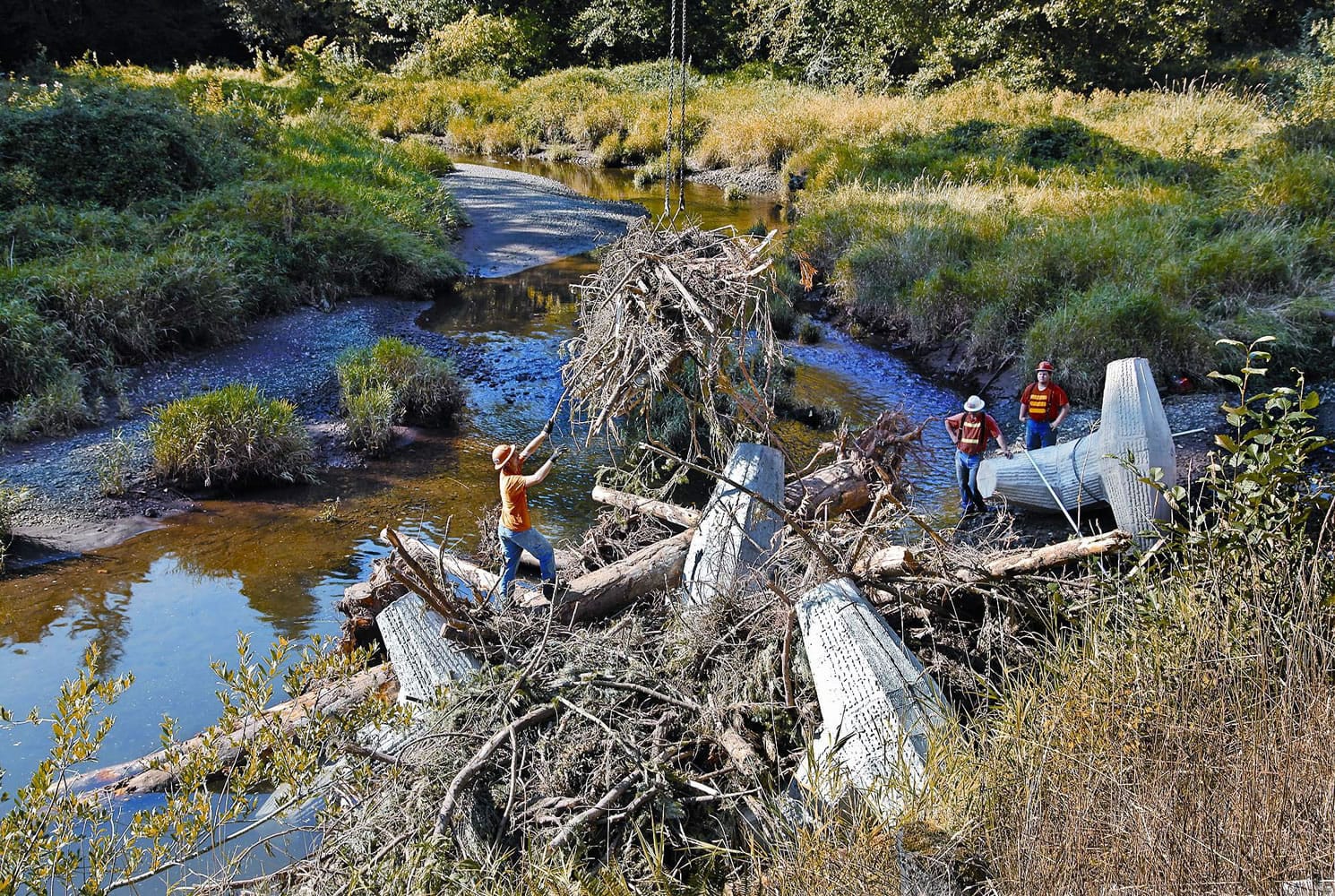LONGVIEW — Sixty oddly shaped 8-ton chunks of concrete are making history in the effort to rebuild runs of wild fish.
Recently, a crane dropped the last of concrete “dolos” into Germany Creek, which flows into the Columbia River 10 miles west of Longview.
“This is the first project of its kind in the world,” said Chad Krofta, an engineer for Cardno ENTRIX, an environmental engineering firm that developed the structures.
Germany Creek Road was closed to traffic while a crane crew installed the dolos, which are rounded lengths of concrete roughly in the shape of an anchor.
Dolos were invented in South Africa in the 1960s to protect shorelines and harbor walls from wave erosion. The structures have been used to stabilize the banks of the Puyallup and Skagit rivers but previously not for improving fish habitat.
“This is the first purely fish-based project to use dolos technology,” said Ian Sinks, the stewardship manager for Columbia Land Trust. That Vancouver-based non-profit organization is the lead agency on Germany Creek habitat restoration.
Like other salmon-bearing streams, Germany Creek lacks logs, stumps and other large woody debris that provide shelter for fish and host the organisms fish eat.
The dolos’ surface is rough like tree bark so moss and plants can get a foothold, just as they do on logs.
“We want a complex surface things can grow on,” Sinks said.
Each of the dozen new artificial log jams in the lower reach of Germany Creek has five dolos. Ten logs and a couple of dump truck loads of woody debris were added to each cluster of dolos.
“If we add complexity it will be easier for the fish to get up the creek,” Sinks said. Fish can hide under the structures, which will cool down the stream in the summer and slow it during floods.
The “engineered log jams” are costing about $300,000, which is coming from a variety of funding sources.
Sinks acknowledged that some people may question how dropping 8-ton pieces of concrete in a stream can be good for fish. It’s far less disruptive than more typical habitat improvement projects, he said. In most cases, heavy equipment is used to drive wooden posts up to 60 feet deep to hold the structures in place, stirring up sediment. Such work is akin to “open-heart surgery for a stream,” said Jamie Glasgow, director of science and research for the Wild Fish Conservancy, which is monitoring fish counts in Germany Creek.
Plunking a dolo down with a crane disturbs the stream bed much less, Krofta said. “We have no turbidity,” Sinks added.
And if the project ever needs modification, a crane can pick up the dolos and move them.
The concrete-and-log additions to Germany Creek are the latest in a series of fish improvements that began seven years ago.
In the past, Germany Creek has supported native runs of summer and fall chinook, coho, chum and winter steelhead. “Historically, it’s been a very productive stream for its size,” Sinks said.
It’s one of the few tributaries of the Columbia that support chum, with 76 adult fish counted in 2003.
But over the decades, logging and development upstream took its toll on the stream. A gravel pit once operated next to the water, several miles upstream from the mouth, and several houses were planned. Parts of the natural streambed was constricted by a dike.
In 2003, the Columbia Land Trust received funding from several agencies and started purchasing land along the lower 1 1/2 miles of the creek. By now, the Land Trust owns 190 acres in the area.
The first phase of the rehabilitation work included removal of the dike, connecting two off-channel ponds to the stream and planting approximately 8,000 native trees and shrubs. In 2008, workers also built five traditional logjams out of tree trunks and cable. Within four months, however, the creek experienced a record flood and the log jams got washed downstream. The heavy dolos should fare better in high water.
Originally, the Land Trust planned to construct a spawning channel for chum, but it shelved the plans because of concerns high water would wash it away.
Sinks said that the valley’s natural habitat took a hit decades ago when Germany Creek Road was built through the middle of the creek’s delta. Project managers considered moving the road to the east. “Then we realized there’s no place for us to put it,” Sinks said.
How well and how soon the structures benefit fish is “a million dollar question,” Sinks said.
The Wild Fish Conservancy has been counting the fish in the stream since 2005 and will continue to track the fish populations, Glasgow said. Fish returns will be compared to those in nearby Abernathy and Mill creeks.
Poachers may skew their figures, however. Though salmon fishing is prohibited in Germany Creek, Sinks said poaching has been a problem in the low-water creek, where fish are relatively easy to spot.
“It’s all for naught if the fish are ripped off the gravel,” Glasgow said.
Already, workers have seen fall chinook swimming upstream despite all the commotion as the dolos and logs are installed. “We’ll come back in spring and hopefully find a lot more use,” Sinks said.
He’s particularly pleased about a fall chinook that was getting chased up the creek by a sea lion. The marine mammal gave up when it got several hundred yards up the creek and the fish found a place to hide amid the debris.
“You could see the sea lion coming up. He just looked frustrated,” Sinks said.



